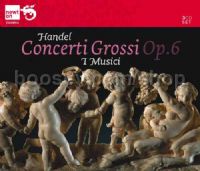12 Concerto Grossi (Newton Classics Audio 3-CD set)
12 Concerto Grossi (Newton Classics Audio 3-CD set)
Special Offer
* Estimated price converted from UK retail price
Handel spent the years 1707-10 in Italy, and he learned much from the composer and violinist Arcangelo Corelli during that period. Corelli developed the concerto grosso form into the major genre for concertante instruments and orchestra. This later evolved to beget the sinfonia concertante, of which Beethoven’s Triple Concerto was a late example.
Handel not only took Corelli’s model and sequence of movements, he also had absorbed much from the French school of orchestral writing, especially the music of Lully. Handel had already composed the 6 concertos Op.3, and by the time he came to compose the 12 concertos Op.6 in 1739 his circumstances were very different to the heady days of the Op.3 set. He had suffered a series of operatic disasters, and was at war with the notoriously partisan operatic establishment in London. On top of this, he suffered a severe stroke. He made a speedy and miraculous recovery, and plunged back into the operatic fray, and produced the oratorios Saul and Israel in Egypt.
What is remarkable is that despite such turmoil, he managed to compose all 12 of the Op.6 set of concertos during the month of October 1739. This set and those that Bach wrote for the Margrave of Brandenburg are justly renowned as the twin peaks of the Barock concerto; for their elegance, variety, poetry and exuberance.
‘The devotion of I Musici to the baroque has until quite recently been centred more on the music than on the stylistic fidelity of its presentation, but most of the romantic ghosts of their past have effectively exorcised. Whatever I Musici may have discarded it
is not the sumptuousness of their sound (though the good recording ensures that it rarely muddies the textures).’ - Gramophone, February 1990




